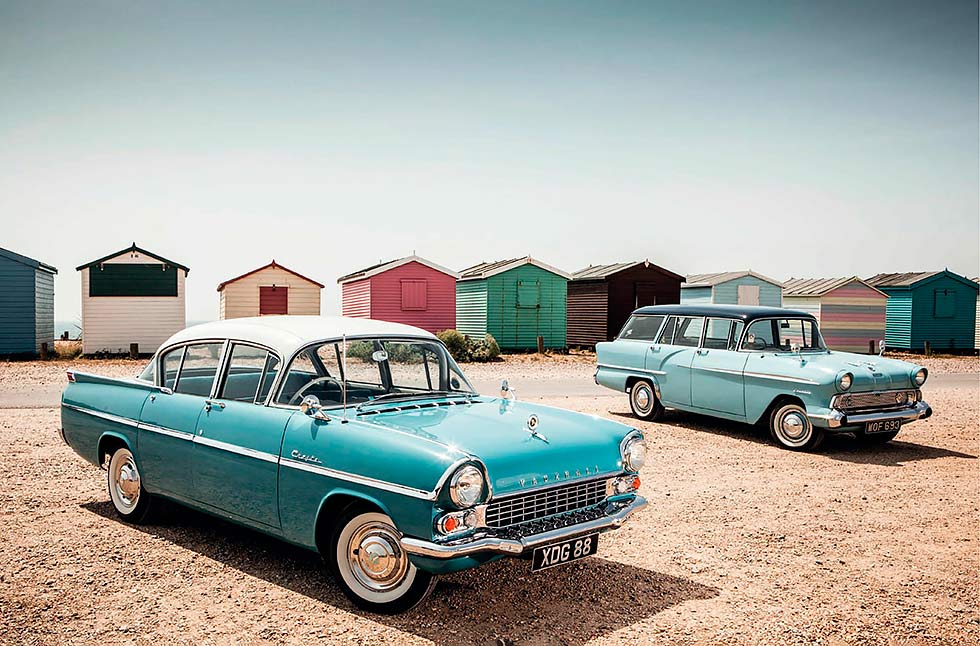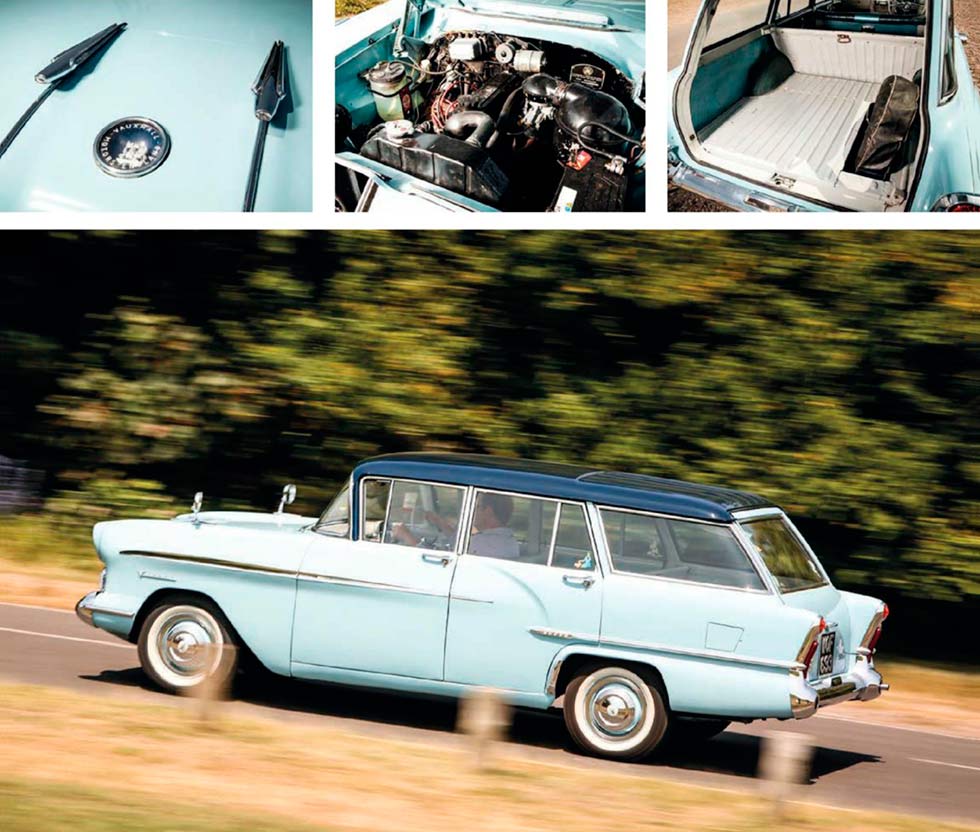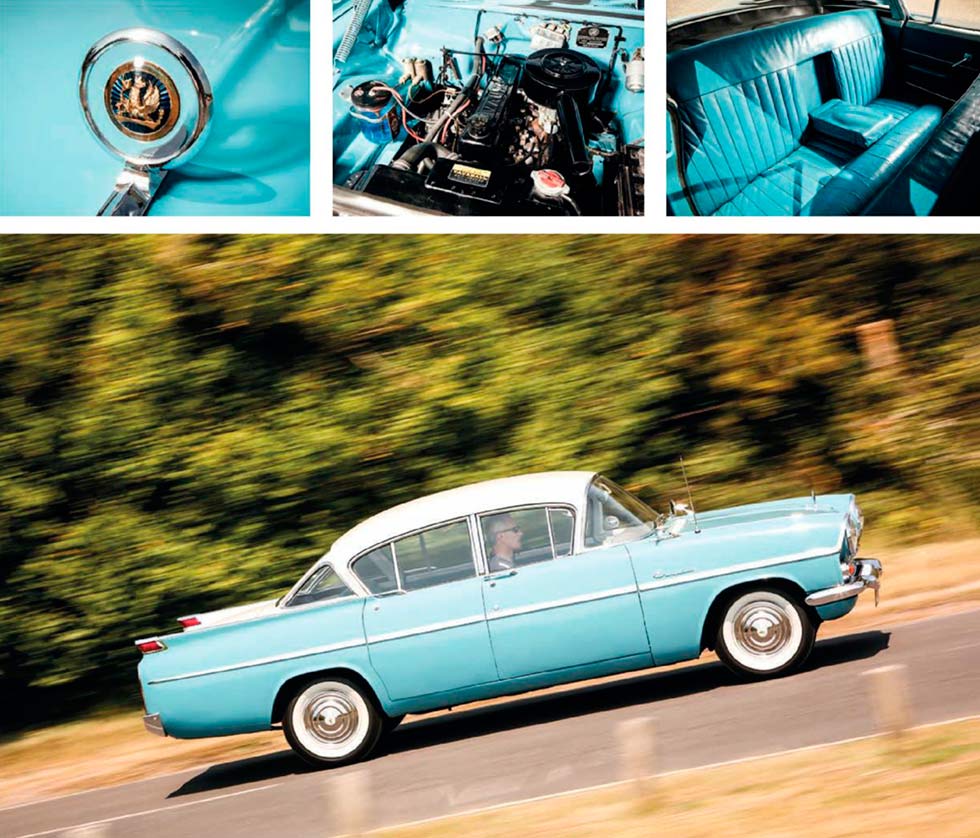
Vauxhall’s Yankee dandies Sizing up PA Cresta and F-series Victor Coffee-bar heroes: Stateside glitzmeets Luton practicality.
DOUBLE ESPRESSO They may be the epitome of ’50s coffee-bar chic, says Andrew Roberts, but the mid-Atlantic style Vauxhall PA Cresta and F-series Victor weren’t as rock ’n’ roll as their image today might suggest. Photography Tony Baker.
One of the prevalent myths about post-war motoring is that Vauxhall’s F-series Victor and PA Cresta were Teddy Boy transport. Given that both have the air of having recently strayed from the set of Expresso Bongo it is an understandable misconception, but it does rather neatly ignore the fact that few drape-jacketed teenagers would have been able to raise over £900 for a car.

In reality, the Victor was for the commercial traveller with an Ian Hendry haircut and suit, cutting a dash as he arrived at his latest sales appointment. The Cresta, meanwhile, was more suited to the Merton Park Studios school of smooth villainy, the owner of a small local factory, or even a brash young estate agent. Yet in the late 1950s a new Vauxhall was the aspirational goal for many a guitarist who had taught himself the chords to Rock With The Caveman and who dreamed of being the next Tommy Steele. The Victor made its debut on 28 February ’1957, with the PA following a little over seven months later, and it would be fair to say that while their lines were not entirely a surprise – Luton had employed Detroit-inspired tropes for the past few decades – few expected them to look that transatlantic. The outgoing E-series range resembled the sort of 1949 Chevrolet favoured by a respectable doctor in small-town America, but the latest Victor, Velox and Cresta positively exuded conspicuous consumption.
In 1954, Vauxhall decided that its next generation of products would be separate four- and six-cylinder models, with the Wyvern being replaced by the Victor. The coachwork was devised by David Jones and his team at Luton in collaboration with Fisher Body Design in the USA and, following a visit to the UK by GM’s president Harlow Curtice, it was decided that the new model would be the first in Europe with a panoramic windscreen. Just to ensure that the F-series received the best possible start, Vauxhall commissioned Ralph Reader (of Gang Show fame) to write a musical extravaganza for the entertainment of an invited audience of dealers at London’s Gaumont State Theatre. The stars of this show were, naturally, two Victors, in addition to two and a half hours of entertainment from Arthur Askey, the lovely Sabrina and the Band of the Grenadier Guards. The intended result was that sales teams would be so enthused they would rush out to market the car with ‘the clean aerodynamic styling of tomorrow’. Furthermore, this was a family saloon so up to the minute that two-speed wipers were standard equipment.
Back in 1957, the letters pages of many newspapers would usually contain at least one irate missive complaining about the creeping Americanisation of Britain, and the Victor could have been designed to deliberately provoke such correspondents’ wrath. In addition to that dogleg windscreen and those tailfins there were vulgar new colour schemes: Harvest Yellow and Gipsy Red instead of black, grey or beige, Then, in February 1958, Luton took a further step on the road to decadence with the Victor estate. Vauxhall had initially planned to launch a five-door version of the F-series simultaneously with the saloon, but production issues meant that its debut had been delayed until the following year.
It was the firm’s first factory-built station wagon and, compared to the saloon, there was a lower axle ratio, the rear springs were five-leaf as opposed to three, and the overall weight was up by 130lb. As befitting an estate car of quality, the trim was to Super standard, meaning that there were twin sun visors, plus ashtrays fore and aft, while no ambitious owner would fail to invest an additional £14 15s for a heater, or £2 16s 6d for ‘Screen Clean’ washers. Alas, the Estate shared the F-series’ famed susceptibility to tin-worm and John Deverell’s example is one of the very few believed still to be on the road in the UK. Autocar tested an estate in 1958 and concluded its evaluation with the sort of headmasterly note that makes magazines of that era so compulsively readable: ‘Much thought has gone into the Victor in order that the extra load capacity can be accommodated without upsetting the balance between appearance, comfort and performance.’
In other words, ‘10 out of 10 – good work.’ For quite a few Vauxhall devotees, including myself, the estate is more aesthetically successful than the saloon. The elongated roofline is emphasised by a duotone finish – a first for the F-series – and the rear has overtones of the Corvette Nomad that was the star of GM’s 1954 Motorama.
Vauxhall’s PR material often placed the Victor in a country house setting, where it looked about as plausible as Wally Whyton & The Vipers topping the bill at La Scala in Milan. In truth, the estate was perfectly suited to the motorist who needed a medium-sized load-lugger with which to peddle samples of cleaning products around the supermarkets of the southern region, the better to pay the mortgage on that new des res.
Of the car’s rivals, the Austin A55 Cambridge MkI could be specified in Utilecon estate form, but that was a Martin Walter conversion of a van – it had only three doors, not to mention a distinct lack of style. Its stablemate, the Morris Oxford Traveller MkIV, boasted four side doors and was undeniably well-appointed, but its image was more akin to Jack Hawkins, pipe smoking and sensible tweed jackets than a vision of eternal summer holidays and open-necked shirts. As for the Ford Consul MkII Farnham and the Audax-series Hillman Minx, both had a more contemporary air but the former looked slightly awkward in comparison with the Victor, while the Rootes estate had a more low-key appeal.
By 1960 the F-series was the UK’s best-selling export model, most famously in Canada where it was marketed as the Envoy via the Chevrolet/ Oldsmobile dealership chain. In the home market, the Victor’s success was largely due to its deceptively clever blend of the flamboyant with the strictly practical. The instrument panel does resemble a jukebox, the chrome is splendidly unrestrained and, on the early versions, the exhaust exits via the rear bumper – a very stylish method of inducing corrosion. Yet every apparent extravagance is balanced by a useful touch – the cabin has plenty of headroom and, even with the rear bench in place, there is 22cu ft of luggage space. As for the wraparound windscreen, it may serve as a deterrent to a brisk exit, but the glass area would have been remarkable in an era of thick pillars and porthole-like windows.
Power is from the 1.5-litre Bedford CA ‘four’, while the column change has synchromesh on all three ratios, making for a much smoother shift than on certain BMC rivals. The F-series, despite its appearance, was never suited to ‘freeways’ but it was very adept as an A-road cruiser or for gentle perambulation around Hayling Island – even if holidaymakers stare at ‘ours’ in amazement. Perhaps they were fearing an invasion of Teds and excessive jiving amongst the beach huts.
There would be only one other Griffin-badged product of this era to exceed the Victor in terms of sheer chutzpah – the PA, which was the talk of the 1957 Motor Show. The 2.2-litre engine was the same as the last of the outgoing E-types, but the new car looked very different to its predecessor. ‘Behold the low and lovely lines of these latest Vauxhalls’ urged the brochure, and 60 years on it still chimes. Steve Godden’s exceptionally handsome Cresta has the ‘three-window’ rear of the 1957-’1959 models and carries a presence that comes with only the most interesting of vehicles. Motor found it to be ‘smartly fashionable in appearance but not exaggeratedly flashy’ and the PA is an undeniably well-proportioned car. Many marque enthusiasts regard it as one of Vauxhall’s most accomplished designs, from the ‘harmonica’ grille to the indicators in the fins and that wonderful curved roof.
In short, the latest generation of Luton’s big saloons could never be a low-profile form of transport. As someone with an abiding fascination for post-war pop culture, the Cresta always struck me as the automotive equivalent of those British actors who liked to affect a mid-Atlantic accent. It may have hailed from Bedfordshire, but the Vauxhall would still provide the impression of hailing from 77 Sunset Strip.
The entry-level model was the Velox, but even with its comparative dearth of external brightwork, or when serving as a taxi or police car, it still managed to be the epitome of ‘bold dynamic beauty’. Meanwhile, the flagship Cresta was the only real choice for the discerning motorist who craved ‘enhanced prestige’. The list of fittings included a cigarette lighter, a clock above the rear-view mirror, windscreen washers, two-tone paint, plus upholstery in ultra-fashionable nylon and Elastofab. This was the car for the ambitious property developer, wartime spiv turned ‘legitimate businessman’, or skiffle band leader who’d made the bigtime; the boot was certainly big enough to accommodate any number of guitars.
The PA competed directly with the Austin A105 Westminster and the Zodiac MkII, both of which were strong rivals. The BMC offering was handsome in its substantial fashion and fully equipped, but it had a more formal air. The Ford, meanwhile, was as accomplished an interpretation of Americana as the Vauxhall yet was marginally more conservative. The Luton product could never be accused of understatement, and perhaps its impact is best appreciated when you look at Pathé newsreel footage of the late ’50s. Among the FX3 taxis, Commer vans and battered pre-war Morris Eights, the Velox and Cresta have the appearance of roadgoing spaceships.
Best of all, the Cresta’s looks are reinforced by genuine ability. It has no claims to be a sports saloon in the manner of a Jaguar Mk1 and, unlike the Citroën DS, it neither inspired a Roland Barthes essay nor altered our perception of motoring. But it could transport five adults in comfort with an effortless sense of flair. Just manoeuvre the column change into third, watch the speedometer needle gently move towards the 70 mark, and you have a sense of a Vauxhall that anticipated the motorway age. Viewing Hampshire through the windscreen gave me illusions of being Kenneth Cope in Death Trap – but then the Cresta is a car that encourages dreams.
Both the F-series and PA were updated during their careers, the former becoming slightly muted as it entered middle age and the latter gaining a wraparound rear screen, optional front disc brakes and Hydramatic transmission. The Victor was replaced by the FB in 1961 and the PA by the PB in 1962, the timing of their departures being as immaculate as their introduction. They made their bow in the year that Harold Macmillan became Prime Minister, that the BBC commenced broadcasts of The Six-Five Special and Paul McCartney joined John Lennon’s band The Quarrymen. The final befinned PA departed the factory into a world of That Was The Week That Was and Love Me Do.
The Vauxhall F-series Victor and PA Cresta were never Teddy Boy cars per se, but they were emblematic of a brave new world of coffee bars, Lionel Bart tunes and consumer affluence. To employ a very over-used expression, they really did capture the zeitgeist. And anyone who disagrees is an obvious square, daddio.
‘THE VICTOR, VELOX AND CRESTA POSITIVELY EXUDED CONSPICUOUS CONSUMPTION’
Tech and photos
TECHNICAL DATA FILE SPECIFICATIONS Vauxhall F-Series Victor
Sold/number built 1957-’1961/390,747 (all types of F-series)
Construction steel monocoque
Engine cast-iron, ohv 1508cc ‘four’, single Zenith carburettor
Max power 55bhp @ 4200rpm / DIN
Max torque 84lb ft @ 2400rpm / DIN
Suspension: front independent, by double wishbones, coil springs, anti-roll bar rear live axle, semi-elliptic leaf springs; telescopic dampers f/r
Transmission three-speed manual, RWD
Steering Burman recirculating ball
Brakes drums all round
Length 13ft 11 ½ in (4255mm)
Width 5ft 2 ½ in (1588mm)
Height 4ft 10in (1473mm)
Weight 2325lb (1055kg)
0-60mph 28 secs
Top speed 73mph
Mpg 31
Price new £931 7s
Price now £8-12,000
TECHNICAL DATA FILE SPECIFICATIONS Vauxhall Pa Cresta (where different)
Sold/number built 1957-’1960/81,841 (inc Velox)
Engine 2262cc ‘six’
Max power 82bhp @ 4400rpm / DIN
Max torque 124lb ft @ 1800rpm / DIN
Length 14ft 10in (4521mm)
Width 5ft 8 ½ in (1740mm)
Height 4ft 9in (1500mm)
Weight 2646lb (1200kg)
0-60mph 16.8 secs
Top speed 90mph
Mpg 23
Price new £1073 17s
Price now £10-20,000








